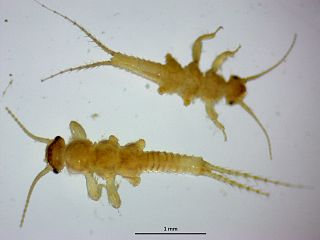
The Pteronarcyidae, also known as giant stoneflies or salmonflies, are a family of the order Plecoptera.

Pteronarcys californica is a species of insect in the family Pteronarcyidae, the giant stoneflies and salmonflies. It is known commonly as a salmonfly. Salmonflies are an important aquatic insect for fly anglers and many nymph and adult fly patterns are tied to imitate this insect.

Autohaemorrhaging, or reflex bleeding, is the action of animals deliberately ejecting blood from their bodies. Autohaemorrhaging has been observed as occurring in two variations. In the first form, blood is squirted toward a predator. The blood of these animals usually contains toxic compounds, making the behaviour an effective chemical defense mechanism. In the second form, blood is not squirted, but is slowly emitted from the animal's body. This form appears to serve a deterrent effect, and is used by animals whose blood does not seem to be toxic. Most animals that autohaemorrhage are insects, but some reptiles also display this behaviour.

Parks' Salmonfly is a traditional dry fly imitating adults of the family of giant stoneflies or salmonflies (Pteronarcyidae). The most commonly imitated species is Pteronarcys californica or salmonfly common throughout Western North America from British Columbia to California.

Pteronarcys biloba, the knobbed salmonfly, is a species of giant stonefly in the family Pteronarcyidae. It is found in North America.

Pteronarcys is a genus of giant stoneflies in the family Pteronarcyidae. There are about 8 described species in Pteronarcys.

Pteronarcys princeps, the ebony salmonfly, is a species of giant stonefly in the family Pteronarcyidae. It is found in North America.

Zapada cinctipes, the common forestfly, is a species of spring stonefly in the family Nemouridae. It is found in North America.

Pteronarcys pictetii, the midwestern salmonfly, is a species of giant stonefly in the family Pteronarcyidae. It is found in North America.

Perlinella is a genus of common stoneflies in the family Perlidae. There are at least three described species in Perlinella.
Castianeira dorsata is a species of true spider in the family Corinnidae. It is found in the United States and Mexico.

Clioperla is a genus of green-winged Nearctic stoneflies in the family Perlodidae. It is monotypic, being represented by the single species, Clioperla clio.
Utaperla is a genus of green stoneflies in the family Chloroperlidae. There are at least four described species in Utaperla.

Nemoura is a genus of spring stoneflies in the family Nemouridae. There are more than 190 described species in Nemoura.
Doroneuria is a genus of common stoneflies in the family Perlidae. There are at least two described species in Doroneuria.
Pteronarcella is a genus of giant stoneflies in the family Pteronarcyidae. There are at least two described species in Pteronarcella.

Pteronarcys proteus, the Appalachian salmonfly, is a species of giant stonefly in the family Pteronarcyidae. It is found in North America.
Podmosta is a genus of spring stoneflies in the family Nemouridae. There are about six described species in Podmosta.

Strophopteryx fasciata, the mottled willowfly or early brown stonefly, is a species of winter stonefly in the family Taeniopterygidae. It is found in North America. Larvae are herbivorous and emerge as adults in late winter to early spring. This species is also known to tolerate waters of various qualities.

Salmon fly patterns are an important collection of artificial flies used by fly anglers to imitate nymphal and adult forms of Pteronarcys californica a giant stonefly or salmon fly. Salmon flies are common in high gradient, freestone rivers and streams from Western Canada throughout the Western U.S. to Mexico in the Rocky Mountains and coastal mountain ranges. Nymphs live for three to five years before adult emergence which typically occurs in late Spring or early summer. The long lifespan of the nymphal form provides year-round angling opportunities for fly anglers.















